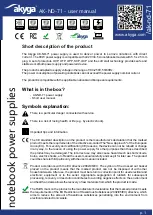
Model G0796/G0797 (Mfd. Since 1/18)
-51-
Review the troubleshooting procedures in this section if a problem develops with your machine. If you need
replacement parts or additional help with a procedure, call our Technical Support.
Note: Please gather the
serial number and manufacture date of your machine before calling.
SECTION 7: SERVICE
Troubleshooting
Motor & Electrical
Symptom
Possible Cause
Possible Solution
Machine does not
start or a breaker
trips.
1. Plug/receptacle at fault/wired wrong.
2. Incorrect power supply voltage/circuit size.
3. Power supply circuit breaker tripped or fuse
blown.
4. Motor wires connected incorrectly.
5. Wiring open/has high resistance.
6. Spindle rotation switch at fault.
7. Start capacitor at fault (G0796).
8. Centrifugal switch at fault (G0796).
9. Motor at fault.
1. Test for good contacts; correct the wiring.
2. Ensure correct power supply voltage/circuit size.
3. Ensure circuit is sized correctly and free of shorts.
Reset circuit breaker or replace fuse.
4. Correct motor wiring connections.
5. Check/fix broken, disconnected, or corroded wires.
6. Replace switch.
7. Test/replace.
8. Adjust/replace centrifugal switch if available.
9. Test/repair/replace.
Machine stalls or is
underpowered.
1. Machine undersized for task.
2. Feed rate/cutting speed too fast.
3. Wrong workpiece material.
4. Belt(s) slipping.
5. Oil/grease on belt(s).
6. Motor wired incorrectly.
7. Spindle rotation switch at fault.
8. Gearbox at fault.
9. Motor overheated.
10. Pulley/sprocket slipping on shaft.
11. Centrifugal switch at fault.
12. Motor bearings at fault.
1. Use correct cutter/bit; reduce feed rate; reduce
spindle RPM; use coolant if possible.
2. Decrease feed rate/cutting speed.
3. Use correct type/size of metal.
4. Tension/replace belt(s); ensure pulleys are aligned.
5. Clean belt(s).
6. Wire motor correctly.
7. Test/replace switch.
8. Select appropriate gear ratio; replace broken or
slipping gears.
9. Clean motor, let cool, and reduce workload.
10. Replace loose pulley/shaft.
11. Adjust/replace centrifugal switch if available.
12. Test/repair/replace.
Machine has
vibration or noisy
operation.
1. Workpiece loose.
2. Belt(s) worn or loose.
3. Motor or component loose.
4. Chuck or cutter at fault.
5. Belt(s) slapping headstock casting/guard.
6. Motor fan rubbing on fan cover.
7. Pulley loose.
8. Machine incorrectly mounted.
9. Motor bearings at fault.
10. Centrifugal switch is at fault (G0796).
1. Use the correct holding fixture/reclamp workpiece.
2. Inspect/replace belts with a new matched set.
3. Inspect/replace damaged bolts/nuts, and retighten
with thread locking fluid.
4. Replace unbalanced chuck; replace/resharpen
cutter; use correct feed rate.
5. Replace/realign belts with a matched set.
6. Fix/replace fan cover; replace loose/damaged fan.
7. Re-align/replace shaft, pulley set screw, and key.
8. Tighten mounting bolts; relocate/shim machine.
9. Test by rotating shaft; rotational grinding/loose shaft
requires bearing replacement.
10. Replace.
Содержание G0796
Страница 96: ......
















































